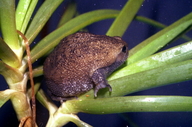|
Breviceps verrucosus Rapp, 1842
Plaintive Rain Frog | family: Brevicipitidae genus: Breviceps |
 © 2011 Martin Pickersgill (1 of 7) |
|
|
|
Description The snout vent length is up to 53 mm. Males are considerably smaller than females, weighing only one-third what the females weigh on average (Passmore and Carruthers 1995). The head is very small in relation to the globular body, with a flat face and short snout (Passmore and Carruthers 1995). The tympanum is generally visible (Passmore and Carruthers 1995) but may be covered with granules in some specimens (Channing 2001). The skin is granular both dorsally and ventrally, with dorsal granules large and pitted (Passmore and Carruthers 1995). A pair of glandular, parallel ridges runs longitudinally from behind the eyes to the posterior (Wager 1986). Limbs are short and stout, and hands and feet lack webbing (Bates 1995). The toes are long, with the fifth toe extending beyond the level of the basal tubercles of 4th toe; tip of 1st toe reaching the basal tubercle of 5th toe; 5th toe longer than 2nd toe, 1st toe half the length of the 2nd toe and extending beyond basal tubercle of 2nd toe (Bates 1995). Color varies dorsally from tan, gray, or black, to a light brown mottling on a dark brown background (Passmore and Carruthers 1995). The dorsal ridges may be lighter in color than the rest of the dorsal skin. There is also sometimes a light vertebral line, as well as a light line that extends along the back of the legs from heel to heel (Passmore and Carruthers 1995). Ventral skin is off-white with a creamy mottling (Lambiris 1988). Distribution and Habitat Country distribution from AmphibiaWeb's database: Lesotho, South Africa, Swaziland
Breviceps verrucosus is found in South Africa, Lesotho, and Swaziland. It occurs from the Nico Malan Pass in Eastern Cape Province to KwaZulu-Natal in Swaziland, to the Blyde River Canyon Nature Reserve in Mpumalanga (Minter 2004). It occurs in grassland, shrubland, and forest in temperate to dry climates (IUCN, 2006) at elevations up to 3000 m (Bates 1995). It has also been found in residential areas adjoining forest (Channing 2001). Life History, Abundance, Activity, and Special Behaviors This frog is fossorial, using the metatarsal tubercles and the hind feet to displace soil. It is not associated with any bodies of water; however, it is known to emerge from its burrow during exceptionally rainy periods (Passmore and Carruthers 1995). If the frog is disturbed while in its burrow, it will blow its body up into a large ball shape, making itself difficult to remove from the burrow (Passmore and Carruthers 1995). The breeding period is short, running from the beginning of the rainy season in late August/early September to about mid-November (Minter 2004). Males usually call from concealed, shallow depressions in matted grass or leaf litter, but will also call conspicuously from the surface (Minter 2004) or perched 10-40 cm above ground on vegetation or a rock (Poynton and Pritchard 1976; Channing 2001). Poynton and Pritchard (1976) note that males will only call when rain falls, except at the very beginning of the mating season (August-September). Minter (2004) has reported that they will be prompted to call following a tape-recorded, human imitation of the call, even when no other calling is taking place. The call has been recorded by Passmore and Carruthers (1995) and described as "a mournful, protracted whistle, repeated slowly, about one call every three seconds." The call note duration is up to 0.6 s, with a dominant frequency of 2 kHz (Channing 2001). Amplexus is inguinal but since the arms are so short, the male essentially glues himself to the female by secreting a sticky, white substance to the posterior region of the female (Passmore and Carruthers 1995). It is speculated that the tadpole stage is spent inside the burrow, but little is known about the tadpoles' life history, behavior, or morphology (Minter 2004). Adults will eat amphipods, isopods, juvenile myriapods, caterpillars, beetles, and ants (Poynton and Pritchard, 1976). The species is widely distributed and abundant throughout its habitat, and its population is not considered to be at risk (Minter 2004). Trends and Threats The species' main threat is habitat loss caused by agricultural land use for large-scale wood plantations (IUCN 2006). Protected areas have been established, such as the Golden Gate Highlands National Park (Bates 2005), but more research on habitat, ecology, population trends, and potential conservation measures is needed (IUCN 2006). Possible reasons for amphibian decline General habitat alteration and loss
References
Bates, M. F. (1995). ''Distribution and diversity of amphibians in the Free State, South Africa.'' Madoqua, 19, 3-14. Channing, A. (2001). Amphibians of Central and Southern Africa. Cornell University Press, Ithaca, NY. IUCN, Conservation International, and NatureServe (2006). Global Amphibian Assessment: Breviceps verrucosus. www.globalamphibians.org. Accessed on 14 March 2008. Lambiris, A. J. L. (1988). ''A review of the amphibians of Natal.'' Lammergeyer, 39, 1-210. Minter, L. R. (2004). ''Breviceps verrucosus.'' Atlas and Red Data Book of the Frogs of South Africa, Lesotho and Swaziland. SI/MAB Series #9. Smithsonian Institution, Washington, D. C., 194-195. Passmore, N. and Carruthers, V. (1995). South African Frogs, a Complete Guide. Witwatersrand University Press, Johannesburg, South Africa. Poynton, J.C., and Pritchard, S. (1976). ''Notes on the biology of Breviceps (Anura: Microhylidae).'' Zoologica Africana, 11(2), 313-318. Wager, V. A. (1986). Frogs of South Africa: Their Fascinating Life Stories. Delta Books, Craighall. Originally submitted by: Sarah Richman (first posted 2008-03-20) Edited by: Kellie Whittaker (2008-05-09) Species Account Citation: AmphibiaWeb 2008 Breviceps verrucosus: Plaintive Rain Frog <https://amphibiaweb.org/species/2383> University of California, Berkeley, CA, USA. Accessed Jun 1, 2025.
Feedback or comments about this page.
Citation: AmphibiaWeb. 2025. <https://amphibiaweb.org> University of California, Berkeley, CA, USA. Accessed 1 Jun 2025. AmphibiaWeb's policy on data use. |


 Map of Life
Map of Life